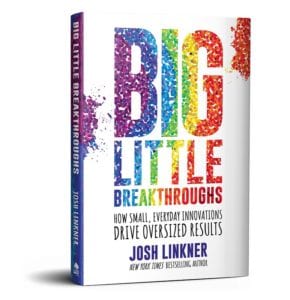Big Little Breakthroughs With Josh Linkner
Posted by John Livesay in podcast0 comments

Many people are stuck with exciting ideas that could cause significant changes but cannot bring them to the surface because of the lack of resources, funding, and motivation. But by embracing creativity and doing even the smallest, everyday innovations, you can finally realize your full potential. John Livesay is joined once more by Josh Linkner, the author of Big Little Breakthroughs, this time to share how the best concepts always start with lousy drafts and several revisions, all fueled by that single spark just waiting to grow. Josh also discusses how jazz music taught him to become creative in real-time and as fast as possible. Furthermore, he talks about his concept of “dinner mint,” which is all about making a huge impact even with just the smallest yet interesting effort.
—
Listen to the podcast here
Big Little Breakthroughs With Josh Linkner
How Small, Everyday Innovations Drive Oversized Results
Our guest in is Josh Linkner. He’s the author of Big Little Breakthroughs. We talked about creativity and how everyday people can become everyday innovators. Let go of the thought that you’re not creative. It’s not true. He said, “Start before you’re ready.” We also talked about how jazz is creativity in real time. He has a great tip about making sure that you do something that he calls the dinner mint. Enjoy the episode.
—
Our guest is Josh Linkner, who you might remember from being on the show earlier. He’s got a new book out. He is known as a creative troublemaker. He passionately believes that all human beings have incredible creative capacity and he’s on a mission to unlock innovative thinking and creative problem solving to help leaders, individuals and even community soar. He’s been the founder and CEO of five tech companies which sold for a combined value of over $200 million. He’s the author of four books, including the New York Times bestsellers Disciplined Dreaming and The Road to Reinvention.
He’s invested and mentored over 100 startups and is the Founding Partner of Detroit Venture Partners. Josh serves as a Chairman and Cofounder of Platypus Labs, which is an innovation research training and consulting firm. He’s twice been named the Ernst & Young Entrepreneur of the Year and is the recipient of the US Presidential Champion of Change Award. He’s also a passionate Detroiter, a father of four, a professional-level jazz guitarist and has an odd obsession with greasy pizza. Josh, welcome back to the show.
Surely a pleasure to be with you.
[bctt tweet=”Creativity is a skill anyone can work on.” username=”John_Livesay”]
Likewise. Your latest book we were talking about, Big Little Breakthroughs: How Small, Everyday Innovations Drive Oversized Results. Before we jump into your personal story, let’s dive into the story of the book cover, for those who haven’t seen it yet, which looks like a piece of art.
The whole principle of the book is democratizing innovation. We hear about people like Elon Musk and we can be happy for them but you say, “I could never do that.” This book is for innovation for the rest of us. It focused on helping everyday people become everyday innovators. What it does is dispels the myth that innovation has to be giant. In fact, it encourages people to think small and the notion is by putting together lots of small micro innovations, lots of everyday innovations and making a habit of creativity. That is what unlocks people’s potential. The book cover with that context, it’s a pointillism painting. Any one of us can put one simple dot of primary color on the page, the actual individual dot isn’t that difficult. When you put enough dots in the right order and it adds up to something great, that was the art form of pointillism and the inspiration for the cover of the book.
Let’s tap into your expertise in jazz because that’s an easy connect the dots, no pun intended. The way to talk about innovation and innovation is part of jazz.
Jazz is a beautiful art form, in my opinion, whether people like listening or not. It’s cool because it’s spontaneous innovation. It’s creativity in real-time. When I play jazz, less than 1% of the notes are on the written page and the rest of it you have to improvise as you go. It reminds me of the business world that we’re all living in. We’re not given an instruction manual. We have to figure stuff out as we go, which is basically like playing jazz. The cool thing that I learned is that jazz musicians themselves, certainly me included, are no more creative than anybody else but the cultural boundaries of playing in a jazz combo encourage responsible risk-taking and these little breakthroughs along the way. I would say that individually, we are all creative like all human beings are creative. If you put them in the right setting and give them the right structure, we all can to a degree improvise our way forward.
This concept of a lot of people being told as a child or as a self-esteem issue is like, “I’m not creative. I’m not innovative.” If I would look at the theme of your whole career and all of the books that you’ve put out, that’s the myth that you’re busting. When people do start to realize that, “Maybe I am creative and I am somewhat innovative. It doesn’t have to be comparing myself to Elon Musk, I can do it.” What I love about this book is you give us an anatomy of an idea almost like a doctor. We start with this concept of how do we expand our input base? What are your ideas around that?
You touched on something important there, which is too many people don’t feel creative at all. To me, that’s a tragedy. It’s not my opinion. The research is crystal clear that every human being has enormous reservoirs of creative capacity. Your brain is wired as the same as Leonardo da Vinci’s, Paul McCartney’s and Beyoncé’s brain. We have the hardware and capacity, it’s a learned skill. It’s not 1 out of 1,000 of us are creative and the rest of us have to suffer. The other key point here is that we can be creative in our own ways.
[bctt tweet=”Start before you are ready.” username=”John_Livesay”]
I play jazz guitar pretty well. I can’t draw a stick figure if I tried when my third-grade teacher looked at my art and says, “You’re not creative,” what a tragedy. I would encourage everyone to expand your definition of what creativity looks like. We think it only means painting on canvas, doing interpretive dance or something. Why can’t you be creative as a customer service rep, furniture manufacturer, car salesman or writing a line of code? My point is we can all discover ways to express creativity but we all absolutely have it within all of us.
I remember when I was taking a Photo Journalism class in college and the professor said, “Photography is painting with light.” Suddenly, for me, a light bulb went on. I’m like, “I can never paint but I could paint with light?” The way I structure apertures on camera. It was a completely eye-opening way of expressing creativity for me. The other thing you talk about is sparks. What sparks an idea? What sparks a conversation? What you’ve tapped into here is an unspoken feeling that so many people have which is, “I’m a perfectionist and if I can’t do something perfectly, I’m not going to even try. I’m certainly not going to say anything out loud.” Yet you have a concept around encouraging people not to ignore those sparks.
Backing up, you started talking about the anatomy of an idea. I answered a different question that you asked. What I did is I tried to put the creative process, which seems squishy, mysterious and stick it under a microscope and say, “Could we dissect that? Is it wizardry that is some magical power or is it more a magic trick that any one of us could learn to do?” That’s what I discovered. If you dissect an idea, it has different components. The first one you talked about is inputs. Before you come up with an idea, what are the inputs going into it? It’s the ingredients before you make a new stew. Those inputs could be your background, experience, training and learnings that you have.

Everyday Innovations: When you have an idea, do not pressure yourself that it has to be the final work product.
In short, if you want to be more creative and have more creative outputs, it’s helpful to have more creative inputs. The second little part of the anatomy that you’re discussing there is called sparking. You’re exactly right. Too many people think that an idea has to be perfect at launch. It pops out of your head, it’s in a binder, there are tabs and everything lines up. It’s perfectly formatted for the PowerPoint and there’s this bulletproof financial model. When we put the pressure on ourselves to have a perfect idea upon launch, we then look at the first draft and say, “I’m not very creative.” The truth is this. There’s a wonderful saying, I love this, “The one thing that great authors have in common, lousy first drafts.” It gets back to this notion of sparking. When we have an idea, let’s not put the pressure on ourselves.
That idea has to be the final work product. It’s the beginning, not the end. It’s a spark. We’ve got to let ourselves have some time sparking and not judging and not prematurely extinguishing those sparks. Realizing that an initial idea might be flawed but it’s the idea that leads to the idea that leads to the other idea that becomes the magic you’re seeking. In that sparking phase, I want people to let their hair down, send your linear analytical mind off for a Starbucks and let your creativity flow.
Not judging yourself and being in a safe space where other people aren’t judging. From my advertising days, it’s almost like improv, “Yes and not, that’s stupid.” It’s filling in that acting analogy. You talk about taking it out for a little audition and this is a part of your expertise in why you’ve been so successful in startups, I believe. It’s you understand before launching something in a big way the importance of getting a product-market fit, if you will or somebody will pay for something that you think they need. In the framework of auditioning and ideas, it’s clever. What is it that people could do to start an easy audition?
[bctt tweet=”Jazz is creativity in real-time.” username=”John_Livesay”]
Thanks for that. I’ll get back quickly on your previous point. We want to give ourselves creative freedom. If you’ve ever been in a meeting, I’m sure we’ve all been in this meeting, there are five people in the meeting. One person has an idea and the other four become the instantly appointed idea police. They tell you all the reasons that idea is never going to work. We need to give ourselves the creative freedom to let the ideas breathe. Back to auditioning, that’s the other big obstacle when people think about innovation. First of all, it has to be a billion-dollar idea or it doesn’t count, which puts so much pressure on you that we end up doing nothing. We agree that we can have small ideas that are still meaningful.
The second thing is instead of having an idea, the way you test it as you roll it out to every customer and your entire company all at once, why don’t you give it an audition which is embracing an experimentation mindset? The best way to de-risk ideas is to test them before launching them fully. When I say test them, it’s small controlled tests. Next time, fix-money tests. As a leader and when I say leader, you could be a leader of yourself, leader of a big company or anywhere in between, we should all be giving and conducting 5 or 10 tests a week. Those little experiments or auditions are our wonderful chance for us to see if there’s any product-market fit. If there is, double the size of the experiment. If not, let it go. There’s nothing wrong. We’ve been told that failure is like a four-letter word. There’s nothing wrong with 4 out of your 5 ideas not working out at all because that one that’s left, that’s the gem you might be looking for.
When we also say, “Now I need to refine something.” This analogy you have of sanding something to perfection. How do you know when something is ready to go? In your book, there are many versions of the manuscript but at a certain point, a lot of people have analysis paralysis. “It’s still not ready to let this out into the world.” My question around the refinement stage is when is good enough, enough? When do you feel like this is something that people should not keep obsessing on?

Everyday Innovations: The best way to de-risk ideas is to test them before launching them fully.
There’s no magical answer, obviously. It depends on the medium of work that you’re shipping. We were going in order. You talked about sparking and auditioning. Refining is, let’s say you audition 100 ideas and there are three remaining candidates. You narrow the field. The question there is, how can we polish them up before launching them? That interim phase is interesting. One of the people that I covered in the book is Lady Gaga. She says, “We often think of this creative act. You write the song and then it’s done. My creative process is I throw up ideas and it’s fifteen minutes. I might spend two years refining it.”
That refinement phase is often overlooked. The difference between great work and mediocre work is the number of refinements. That being said, you bring up an awesome question. How do you know when to launch? My general belief is when you can look yourself in the mirror and know that you’re putting your best foot forward but at the same time, there’s something magical about getting going. It depends again on the medium. If you’re writing a book that’s going to be in the Library of Congress, that might be one thing. Most of us aren’t always doing work that’s permanent. If you’re writing a report or you’re making a sales pitch, I would recommend this principle start before you’re ready which is polish it up, refine it the best you can but don’t wait. Take the initiative, get it out in the market, be willing to adjust, course correct, tweak, adapt and pivot once it’s already launched.
You also brought up an interesting thing of all these ideas being curated down to the top three. Of course, you’re one of the top speakers on creativity, innovation and speak to companies around the world on this. That’s why Big Little is important for the world to know about how to have these breakthroughs in a corporate environment. Oftentimes, people forget that as speakers, we have to convince somebody we’re 1 of 3 choices. You are so good at over-delivering and figuring out why you are what I call the “irresistible” choice. I thought it would be worth asking you about that because I can’t imagine, interviewing you and not asking about your successful speaking career and how you’re applying the Big Little Breakthroughs in your own speaking career.
[bctt tweet=”The difference between great work and mediocre work is the number of refinements.” username=”John_Livesay”]
We spent a time so far chatting about this anatomy and of idea. Half of the book is focused on what I’ve discovered to the eight-core mindsets of everyday innovators. In the book, I spent over 1,000 hours of research and interview people all over the world. Amazing people, champions of industry, CEOs and billionaires but also a lot of everyday people that have done cool stuff. What I discovered are these common patterns or mindsets that are generally embraced. One of those mindsets directly ties to your question about how do you stand out and win in a pitch situation. That principle is what I call “Don’t forget the dinner mint.” Here’s the gist of it. I’m sure you’ve been to a nice restaurant. At the end, they say, “Here you go, sir, here’s this beautiful little piece of chocolate.”
If you order the chocolate, it would be nice and all but it’s the unexpected surprise and delight, the over-delivery even by a teeny bit that makes the meal itself stand out. My suggestion for those pitching because obviously, that’s the theme of the show is you’ve got the basics, the fundamentals of your pitch, the meat and potatoes down then ask yourself this question, “What’s the dinner mint?” I define a dinner mint is no more than 5% extra effort, money or resources but a little creative flourish, a little something extra and a little bit of surprise and delight that elevates your pitch so that it stands out completely from the competitive set. We can apply that sense of creativity to a product, pitch, process, interview or anywhere in between.
One of the other things you write about, which I love now that I live here in Austin, the theme for the whole city is, “Keep it weird.” You talk about being obsessed with reaching out for the weird. Can you give an example of what you mean by that?

Everyday Innovations: A little bit of surprise may elevate your pitch so that it stands out completely from the competitive set.
We tend to, as human beings, gravitate towards what we know. When you make a decision in life, big or small, you might say, “It’s 1 of 3 things. It’s either A, B or C.” Reaching for weird is saying, “Consider, is there a D or E?” I like I to call them option X? Option X is that weird, unorthodox, bizarre idea that could perhaps make all the difference in the world. I cover a whole bunch of them in the book but one fun that comes to mind. There’s a beautiful seaside town in Iceland. It’s idyllic and it’s lovely but they were having a problem that over the years, traffic incidents involving pedestrians had grown by 41%.
That’s a real problem. You don’t want people getting hit by cars. Think about the obvious approach like your A, B and C choices. You could hire more police officers, install expensive new lighting or issue a bunch of fines but they chose the weird approach. Here’s what they did. They repainted the crosswalks as a 3D optical illusion, so when you drive your car up to the sidewalk, it appears that there are these concrete slabs floating 3 feet in the air. There’s absolutely no way you’re going to barrel through the intersection. It added almost no cost and traffic incidents dropped significantly. Those are these magical ideas where it doesn’t take a bunch of money or resources, it takes a little creativity to uncover a remarkably better answer.
The thing that I find inspiring about this book, Big Little Breakthroughs, is when you say it’s time to take your shot. I’m reminded of the musical Hamilton. I’m not going to miss my shot. It ties full circle back to what we were talking about at the beginning where many of us might’ve missed our shot if we were told we weren’t creative. It’s not too late to take our shot, is it Josh? How can people do that?
[bctt tweet=”Take the initiative, get your idea out, then be willing to adjust and pivot once it’s already launched.” username=”John_Livesay”]
I wrote a lot about Lin-Manuel Miranda, the author-composer of Hamilton. He’s done a bunch of other work. We look at this person who’s this genius and I could never be him but Lin-Manuel Miranda is an average person like you and me. He has good days and bad days. He sometimes has fear, doubt and insecurity. The first thing we talked about with him specifically is saying like, “We’re all the same. We all can be creators. Don’t put somebody else on a pedestal when we, ourselves, can be as creative.” I did close the book with that song from him and the notion is it’s never too late. To be creative, it doesn’t mean you have to be Picasso. It doesn’t mean you have to be Mark Zuckerberg in the tech industry. Let’s think about how we can build a habit of everyday creativity.
Big Little Breakthroughs that I write about is micro innovations. Those little big breaks do a couple of things. First of all, when you think about taking your shot, it de-risks it. If you think about your shot as betting your entire life, your house and your family, that’s terrible. Don’t do that. I love these big little breakthroughs because they’re way less risky. Furthermore, when you do a series of them, when it becomes part of who you are, you develop a skill around creativity.
Think about da Vinci, for example. His Mona Lisa is the most famous painting in the world but that wasn’t his first painting. He first had to learn to paint. He had to learn to paint every day. He had to pay bad paintings before he could get to the good ones. By doing big little breakthroughs or ongoing habit of daily creativity, you build your skill in the same way da Vinci did. You get the double benefit of that. These little things add up to big stuff, you’re building your skillset in the process and it’s much less scary and risky.

Everyday Innovations: Everyone has so much creative potential to do everyday innovations. If each one brings something to the surface, the world will be a better place.
If you had a closing story or a closing thought about what’s the cost of someone not taking a big little breakthrough? What is the real compelling reason for people to take action now? You talk about how important it is not to wait. I want people to have a sense of urgency to get big little breakthroughs. What happens if we don’t keep expanding, growing and trying new things?
I feel that too often, we gravitate toward the status quo but then we look back at the end of our lives with regret. I know this is going to sound like a Hallmark card but I believe that all of us have this huge reservoir of dormant creative capacity inside of us. What a shame if we don’t bring it to the surface. In the book, I don’t suggest that people aim for 1,000% improvement or something. I encourage people to consider a 5% creativity upgrade. Five percent is within our reach that we could do that. If you and me and others around the world became 5% more creative, my argument is that would create a disproportionate set of rewards for our environment, kids, healthcare outcomes, the planet and society.
If we have it inside of us, if we have this natural resource that’s untapped, what a shame if we don’t deploy it. I hope that people do that. It is within our grasp. I’ll tell you a brief story. I wrote about a guy who I got the chance to interview named Trewin Restorick. You don’t know who he is because nobody does. He’s an everyday innovator, which I love even more. Trewin was an average everyday person. He went to college, didn’t get good grades, graduated barely, got an okay job, tried to make it through life and pay the bills. He was an absolutely everyday person like you and me. He was not Mark Zuckerberg. He said, “I care about the environment.” He was always drawn to the outdoors and he lived in Central London. It turned out that cigarette butts and litter on the streets of London are the single biggest litter problem that they face.
[bctt tweet=”We all can be creators. Don’t put somebody else on a pedestal and think of yourself less.” username=”John_Livesay”]
Not only is it unsightly but small kids or animals could ingest it. It’s a safety hazard, bad for the environment and caused a bunch of money to clean up. They’ve tried all these things. They tried shaving people to take compliance like, “Don’t litter.” Nothing worked. Here’s Trewin Restorick, an everyday innovator, he comes up with an idea. His idea is he created something called the Ballot Bin, which is a bright yellow painted box that’s mounted at eye level. It could be mounted, for example, on a street pole.
Imagine, this bright yellow bin and the front of it is glass. On the front, it’s asking a question such as, “Which is your favorite food? Pizza or hamburgers. Which is your favorite superhero? Batman or Superman.” What happens is there’s a little receptacle. It’s a big yellow ashtray. As smokers see this, they get to walk over and literally vote with their butts. They put their cigarette butt in. It’s like, “I like Superman better,” and because it’s glass on the front, there’s a divider, you see the tally. It’s a real-time bar chart made out of cigarette butts showing which people prefer.
This idea didn’t require a billion dollars, PhD, fancy training or a bunch of stuff. This guy came and made this Ballot Bin. What happened? Cigarette litter was reduced by 80%. He started a whole company around it. It’s in 27 countries right now. It’s making a massive impact on our planet. Back to your original question, what would happen if Trewin didn’t do that? What a mess. We all have so much creative potential to do everyday innovations like that. If we all brought that to the surface, the world is a better place.
The book again is called Big Little Breakthroughs. There’s a website BigLittleBreakthroughs.com. You can also check out Josh on JoshLinkner.com. Josh, thank you so much for writing this book and inspiring us to unlock our own creativity and realizing that process can be fun and also make a difference. What a great combination.
John, thank you so much. Thank you for this wonderful show and all the love you put back into the world. One last comment. I put something together for your audience. If they go to BigLittleBreakthroughs.com, there’s a button that says Toolkit and that requires a purchase. Don’t purchase it. You can use the word PITCH, obviously in honor of your show, as a secret code and they can get access to anything that’ll be on there. There are all kinds of downloads, worksheets, assessments, and goodies free for all of your audience. Go to the website and use the secret code PITCH.
Thank you so much. Thanks, everybody. Thanks, Josh.
Thank you.
Important Links
- Josh Linkner – Previous episode
- Disciplined Dreaming
- The Road to Reinvention
- Detroit Venture Partners
- Platypus Labs
- Big Little Breakthroughs: How Small, Everyday Innovations Drive Oversized Results
- JoshLinkner.com
- https://JoshLinkner.com/toolkit/ – Use PITCH as a secret code for free content
- Better Selling Through Storytelling Method Online Course
Wanna Host Your Own Podcast?
Click here to see how my friends at Podetize can help
Purchase John’s new book
John Livesay, The Pitch Whisperer
Share The Show
Did you enjoy the show? I’d love it if you subscribed today and left us a 5-star review!
- Click this link
- Click on the ‘Subscribe’ button below the artwork
- Go to the ‘Ratings and Reviews’ section
- Click on ‘Write a Review’
Love the show? Subscribe, rate, review, and share!
Join The Successful Pitch community today:
- JohnLivesay.com
- John Livesay Facebook
- John Livesay Twitter
- John Livesay LinkedIn
- John Livesay YouTube
Tags: concept launch, creator attitude, dinner mint, idea spark, jazz music, level of creativity

